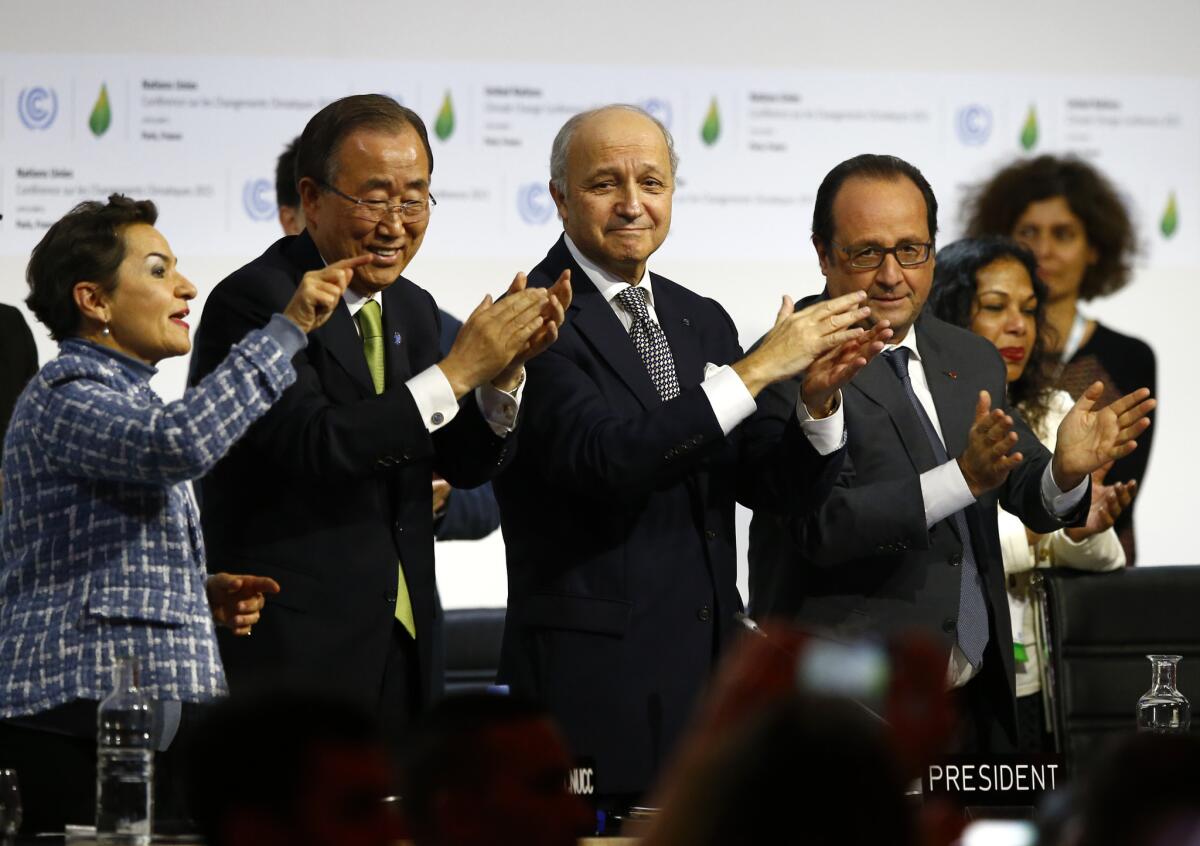Opinion: Paris climate pact: A good moment for the planet

French President Francois Hollande, right, French Foreign Minister and president of the COP21 Laurent Fabius, second, right, United Nations climate chief Christiana Figueres and United Nations Secretary General Ban ki-Moon applaud after the final conference at the COP21, the United Nations conference on climate change, in Le Bourget, north of Paris, on Saturday. Governments have adopted a global agreement that for the first time asks all countries to reduce or rein in their greenhouse gas emissions.
- Share via
It is a document built on hope.
Negotiators for nearly 200 countries agreed in Paris on Saturday to a set of principles and goals that could ratchet back the pace of global warming. Whether the world’s nations can work together to meet the accord’s stated goal of limiting the rise of global temperatures to “well below 2 degrees Celsius” above pre-industrial levels — the point beyond which many scientists believe catastrophic climate change will occur — will be the challenge, even as many scientists and environmentalists question whether the pact’s aspirational target of 1.5 degrees Celsius is low enough. As environmental activist Bill McKibben said, the agreement “didn’t save the planet, but it may have saved the chance of saving the planet.” For that, the accord should be welcomed.
FULL COVERAGE: Paris Climate Change Conference 2015
The talks pitted the needs of the world’s developing nations against the wealth of those — primarily the United States and Europe — that reaped most of the benefits of 150 years of industrialization. Developing nations such as India have argued that they should have the chance to make the same leap forward the industrialized world achieved by burning fossil fuels. That argument rings with fairness, but it’s hardly a reason to add to a global, existential threat.
What differentiates the Paris Agreement from previous international efforts, such as the 2009 Copenhagen Accord, are the breadth of the nations involved and the inclusion of some provisions that were said to be legally binding. But nothing in the deal is truly legally binding, since any of the signatory nations can walk away, and the pact includes little in the way of enforcement.
That’s at least partly a consequence of the pitfalls of American politics. In a bit of legalistic sleight of hand, the pact was structured as an agreement arising from previously approved treaties rather than a new treaty with its own enforcement mechanisms. Had it fallen into the latter category, it would have been subject in the United States to review by Congress, where many Republicans cling to the absurd position that man-made climate change is not happening. In that environment, a deal would have been dead on arrival. So Republican obstinacy was a key factor in limiting how binding the pact could be.
Still, for the first time, countries spanning the globe — rich, rising and poor alike — have committed together to confront climate change. In a world of interconnected economies, the disincentives for any country to turn its back on the accord are high.
Yet it’s unclear whether the agreement’s goals are reachable. Nearly all of the countries that took part in the negotiations submitted pledges of how much they would reduce their carbon emissions by 2030 (the U.S. pledge is to cut emissions up to 28% below 2005 levels by 2025). The aggregate effect, though, is projected to limit global warming to 2.7 degrees Celsius at best. To hold the increase to less than 2 degrees, the pact calls on nations to update their plans every five years beginning in 2020.
The agreement also incorporates, but doesn’t make binding, an earlier pledge by developed nations to provide $100 billion a year by 2020 to help developing nations reach their goals. Such funding is a crucial component in any effective strategy against climate change, yet it may not be enough to build the clean-energy infrastructure those nations need. And, while the pact acknowledges for the first time the disproportionate impact of climate change in low-lying and poorer countries, it leaves unspecified who bears liability for “loss and damages” already underway.
Negotiators dropped specific emissions targets from the agreement in favor of a vague pledge to “reach global peaking of greenhouse gas emissions as soon as possible.” And it says nothing about the world’s production of oil and coal, the major sources of carbon emissions (though it does tip off investors that renewables are the future). India, for instance, has said it plans to double its use of domestic coal by 2019, though in recent days it has said that it will replace some of that with renewable sources if it gets sufficient aid and investment.
Despite the agreement’s shortcomings, this is a good moment for the planet. The pact could have been better, and stronger, but the focus shifts now to getting signatories to live up to their pledges. Because even if they do, it may not be enough.
MORE FROM OPINION
‘I have terminal cancer. And I’m dying in a yearish.’
‘Culture bundling’ and other obstacles to a real gun control debate
Disclosures cast new light on LAUSD’s probe of teacher Rafe Esquith
More to Read
A cure for the common opinion
Get thought-provoking perspectives with our weekly newsletter.
You may occasionally receive promotional content from the Los Angeles Times.






